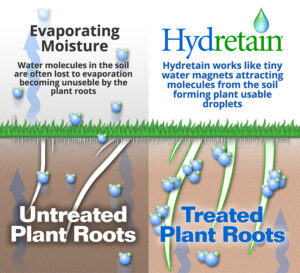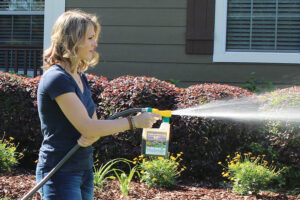3 Landscaping Tips for Austin's Climate

Austin’s unique climate presents a host of challenges for homeowners, from persistent droughts to occasional severe freezes. These conditions demand innovative approaches to gardening and landscaping. HomePoint, always seeking the best for our Members, offers guidance on adopting sustainable landscaping practices that not only withstand these challenges but also contribute to significant water savings and maintenance ease.
1) Hydretain: A Water Conservation Agent
One of the more interesting products in water management for lawns and gardens is Hydretain. This innovative solution addresses the inefficiency in water usage by holding moisture in the soil longer, thus reducing the need for frequent watering by up to 50% [Hydretain’s Scientific Explanation]. For Austin homeowners, especially during times of water restrictions and high utility bills, Hydretain can be a game-changer.

How Hydretain Works
Hydretain functions by attracting and holding water vapor from the air within the soil matrix, effectively turning it into usable water for plant roots. This process significantly cuts down the water lost to evaporation and runoff, ensuring that plants receive the moisture they need during critical growth periods.
2) Timing Oak Tree Trimming to Prevent Oak Wilt
Another critical aspect of maintaining your Austin garden is proper tree care, particularly for oak trees, which are susceptible to Oak Wilt. This destructive disease spreads through beetles and root connections between trees. To mitigate this risk, it is advised to trim oak trees during the least active beetle periods — the heat of summer and the cold of winter [Oak Wilt Prevention Tips].
Best Practices for Oak Tree Care
- Schedule Trimming During Extreme Temperatures: Engage in trimming activities when beetles are less active to prevent the spread of Oak Wilt.
- Sanitize Trimming Tools: Always clean your tools before moving from one tree to another to prevent cross-contamination.
- Monitor for Symptoms: Regularly check your oaks for signs of distress, which could indicate early stages of Oak Wilt, allowing for quicker management interventions.
3) Embracing Weather-Resistant Plants
In response to Austin’s challenging climate marked by extended droughts and freezing winters, it’s crucial for homeowners to cultivate landscapes that not only enhance their property’s beauty but also withstand these environmental stresses. HomePoint partnered with YardDoc to create this short list of recommended plants.
Perennials
- Bi-Color Iris: This perennial offers striking two-toned flowers that bring a vibrant splash of color to any garden. It’s highly tolerant of dry conditions once established, making it a perfect fit for Austin’s climate.
- Variegated Flax: Known for its architectural foliage, variegated flax adds texture and color contrast with its striped leaves. It’s resilient and can thrive in both full sun and partial shade.
- Red Salvia: A magnet for hummingbirds and butterflies, Red Salvia provides brilliant red blooms throughout the summer. It’s extremely heat tolerant and thrives in well-draining soil, making it ideal for sunny Texas gardens.
- Lantana: This hardy plant is celebrated for its clusters of colorful flowers that can endure the hottest summers. Lantana is low-maintenance, requiring minimal watering once established, and is excellent for ground cover or containers.
- Turks Cap: Known for its unique, turban-shaped flowers, this plant is highly adaptable and can flourish in both sun and shade. It’s extremely drought-tolerant and provides a lush, tropical look to the landscape.
- Mexican Bush Sage: With its velvety purple spikes and gray-green foliage, Mexican Bush Sage is a late bloomer that adds a burst of color in fall when many other plants are fading. It’s excellent for xeriscapes and attracts pollinators.
- Foxtail Fern: Despite its name, this plant is not a true fern but is incredibly tough and can handle dry conditions. Its bushy, needle-like leaves create an eye-catching, fluffy texture in the garden or as a potted specimen.
- Thryallis: This small shrub produces masses of bright yellow flowers throughout the year. It’s very low maintenance, thriving in full sun and handling dry spells without fuss.
- Red Yucca: Offering a striking form with its long, arching, sword-like leaves and tall stalks of tubular flowers, Red Yucca is not only drought-resistant but also rarely bothered by pests. It’s perfect for adding structure to your garden.
Shrubs
- Dwarf Yaupon Holly: This compact shrub is highly adaptable and drought-resistant, with attractive evergreen foliage. It’s perfect for creating low, formal hedges.
- Burford Holly: Another excellent choice for hedges, Burford Holly produces dense, glossy leaves and red berries that attract birds. It tolerates a range of soil types and dry conditions once established.
- Abelia: With its cascading branches, small pink flowers, and long blooming period, Abelia is a great addition to softening garden edges. It’s drought-tolerant and attracts pollinators.
- Knockout Rose: Renowned for its disease resistance and continuous blooms from spring until frost, the Knockout Rose is ideal for busy homeowners who want a stunning garden without constant upkeep.
- Boxwood: Known for its versatility in formal landscapes, Boxwood can be shaped into various forms and thrives under a variety of conditions, including drought.
- Loropetalum: This shrub offers unique, fringed flowers and attractive burgundy foliage. It’s a standout for color contrast in the garden and requires minimal water once settled in.
- Drift Rose: Smaller and more manageable than most roses, Drift Roses are repeat bloomers that offer a cascade of color with little maintenance. They are highly adaptable to various soil conditions and drought tolerant.
Screening Trees and Small Trees
- Little Gem Magnolia: This compact variety of the Southern Magnolia offers the same stunning, large white flowers and glossy evergreen leaves but in a much smaller size. It’s perfect for smaller gardens where space is a premium. The Little Gem is remarkably drought-tolerant once established and provides excellent privacy and ornamental value throughout the year.
- Pride of Houston Yaupon Holly: A native to Texas, this tree is highly adaptable and drought-resistant. It features dense, small green leaves and produces attractive red berries that can add a splash of color to your landscape and attract wildlife. It’s ideal for use as a privacy hedge or an ornamental accent in a more naturalistic garden setting.
- Crape Myrtle: Known for its spectacular summer blooms that come in a variety of colors—from pink to red to white—and its attractive, peeling bark, Crape Myrtles are a staple in Southern gardens. They thrive in full sun and can handle drought conditions once they’re well-established. Their ability to grow quickly and adapt to a range of soil types makes them a popular choice among homeowners.
- Arizona Cypress: If you’re looking for a tree that not only survives but thrives under hot, dry conditions, the Arizona Cypress is an excellent choice. It’s often used for windbreaks and privacy screens due to its dense foliage and tall growth habit. The silvery-blue needles add a unique color contrast to the landscape, making it a visually appealing option for large yards.
Conclusion
For Austin homeowners, creating a sustainable and beautiful landscape is more than just a desire—it’s a necessity given the local climate challenges. By implementing innovative solutions like Hydretain to conserve water, strategically timing the trimming of oak trees to prevent the spread of Oak Wilt, and selecting weather-resistant plants tailored to withstand Austin’s extreme weather conditions, you can ensure your garden not only survives but thrives. Each of these strategies plays a crucial role in promoting a healthier, more sustainable garden ecosystem that is both visually appealing and easier to maintain.
